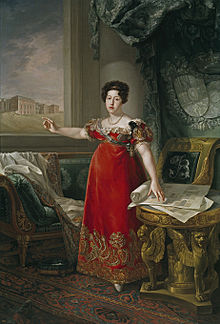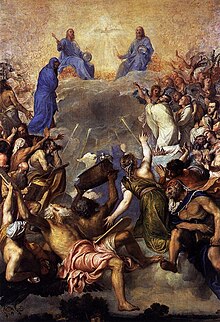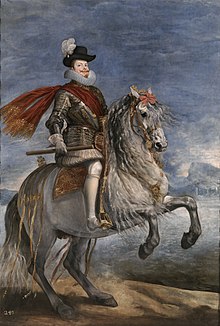Spanish royal collection

The Spanish royal collection of art was almost entirely built up by the monarchs of the
The royal family were the most important patrons of

With the loss of the Low Countries as a result of the Peace of Utrecht, the Spanish crown developed tapestry manufacture in Madrid to avoid the need for imports of these luxury items. As a young man, Goya executed a number of tapestry designs for use in the royal palaces. Royal patronage was also used to develop other arts and crafts in Spain in the 18th century, for example the Real Fábrica de Cristales de La Granja produced luxury glass products.
The enormous collections have been significantly reduced by a series of fires, losses in the
History

Charles V
Few Spanish paintings are recorded in the collection that were owned before the Habsburg reigns. The c. 300 paintings owned by
The collection includes those parts taken to Spain in the 16th century of the collection of the
All of these additions from the Low Countries were probably valued more for their tapestries than their paintings. Charles V spent more on tapestries than paintings (like his contemporary Henry VIII), and commissioned them throughout his life, continuing the family tradition, and reflecting common royal preferences at the time.[8]
The largely German collections of Charles' grandfather Maximilian I, Holy Roman Emperor and the earlier Habsburgs mostly remained in Austria and Germany when in 1556 Charles V abdicated and divided his enormous realms between his brother, who became Ferdinand I, Holy Roman Emperor, and his son Philip, who received Spain, the Netherlands and the Habsburg possessions in Italy. They are now in the Kunsthistorisches Museum, Vienna, and elsewhere.
Charles V was also a keen and discriminating collector, and his relentless travelling made him aware of the diversity of Renaissance art, above all that of Italy.

Philip II
Charles's son Philip II of Spain (reigned 1556 to 1598) was devoted to his father's memory,[13] and probably more interested in art than his father; certainly he commissioned and bought much more, and by the end of his life the collection included some 1,500 paintings,[14] and about 700 tapestries.[15] He took over Charles's key artists, Titian and the Leonis, and commissioned the famous and now dispersed series of mythological paintings known as the poesie, which represent some of his finest late works. Of these six or seven paintings, only one at most of the prime versions remained in the collection until transfer to the Prado; five are now in the United Kingdom, and one in the United States.[16]

In 1561 Philip established Madrid as the capital of Spain, something his father had planned but never implemented. He also began to construct a massive monument to his father and the other Spanish Habsburgs at El Escorial, whose building and decoration was to be the major artistic project of his reign.

Philip III

Philip IV
In great contrast to his father, the long reign of Philip IV of Spain (1621-1665) saw great personal involvement by the monarch in artistic patronage. Diego Velázquez (1599-1660) was brought to the king's attention when still young, after the death of Rodrigo de Villandrando in 1622, and remained in royal service for the rest of his life, also progressing through the hierarchy of courtiers. Philip enjoyed his company, and often came to see him paint. The very informal Las Meninas show the artist painting the king and queen, with their daughter watching.

Velázquez was twice given permission to visit Italy, in 1629-30 and 1649-51. On the second visit he was used as a agent of the king to buy art, which he did on a large scale, with excellent judgement.

Charles II
Charles II of Spain's reign (1661-1700) saw Spain's decline become evident. Royal patronage of official portraits continued, but there was relatively little other than that, and the receipt of diplomatic gifts from other monarchs. Court painters included Juan Carreño de Miranda.

Philip V and Ferdinand VI

After Charles' death, the War of the Spanish Succession from 1701 to 1715 disrupted royal patronage, especially in the early years. The new king, Philip V, was a young French prince, whose reign lasted, with a brief interruption, from 1700 to 1746. French portrait painters were now used heavily, including Jean Ranc and Louis-Michel van Loo, who replaced Ranc as the main court portraitist from 1736, and native Spanish painters like Miguel Jacinto Meléndez needed to adjust their style.
Van Loo remained in place in the reign of Philip's son
Charles III

Reigning over Spain from 1759 to 1788, Charles III was considerably more capable and dynamic than his predecessors for a century before. He had also trained in painting and etching when young (it was a French custom for princes to learn a manual trade) and continued to etch in later life. He twice persuaded Anton Raphael Mengs (d. 1779), the leading painter of Neoclassicism, the avant-garde movement of the day to leave Rome to visit Spain, which successful artists were traditionally reluctant to do. As well as a large ceiling in the Royal Palace of Madrid, several portraits of the royal family remain in the collection.
Mengs was a bitter rival of Giovanni Battista Tiepolo, from a generation earlier. He spent his last years in Madrid, from 1761 to 1770, painting three ceilings in the Royal Palace, and a set of paintings for a church, which were quickly replaced by works by Mengs after court intrigues, apparently reflecting the king's taste. One, The Immaculate Conception reached the Prado in 1827.
In the 1780s Goya began to paint portraits of the court, including the king. He began with a portrait of José Moñino, 1st Count of Floridablanca, Charles's chief minister, in 1783 (Prado), and then painted many of the family of Charles's brother Infante Luis of Spain. In 1786 he was made a salaried court painter.
Charles IV
Goya's position was confirmed by Charles IV and in 1790 he was promoted to First Court Painter. Ill-health, changing artistic inspiration and finally the French invasion of 1808 made his work for the court tail off, but his Charles IV of Spain and His Family (1800-01) is one of the most admired portraits in the Prado. Other works not commissioned by the king reached the Prado later, including La maja desnuda (1790s) and La maja vestida (1800s), and the late Black Paintings.
Though the collection continued to gain paintings from royal commissions after the Restoration, and to acquire older works, the great days of royal patronage culminated with Goya.
Locations
In June 1561 Philip II set his court in Madrid, installing it in the Alcázar, which became home to a huge art collection. The monarchy continued to use other palaces. A new palace was begun in 1563 when the corner-stone was laid of El Escorial, a combined monastery and palace in the mountains to the north of the capital.
In 1734 the Alcázar was destroyed by fire along with many works of art.
The Prado
Many of the finest paintings from the former Spanish royal collection are housed in the
To mark the 200th anniversary of the Prado, the Hall of Realms, a surviving 17th-century wing of the Buen Retiro Palace, is being redeveloped as part of the campus of the museum. Originally, the Hall housed large paintings from the royal collection. Some of these, such as equestrian portraits of the family of Philip IV, are now in the Prado.[19] While in theory these paintings could be restored to their original location, this would disrupt the layout of key galleries of the Prado,[20] and other uses are currently envisaged for the Hall of Realms.
Royal sites

The heritage agency Patrimonio Nacional looks after a number of royal sites in Spain and the art works in them.[21] The
Patrimonio Nacional has a tradition of organising temporary exhibitions, for example in 2019 it mounted an exhibition about
Losses

In 1604 much of the secondary royal palace of El Pardo, then just outside Madrid, was destroyed in a fire. Many paintings were rescued, but the group of important royal portraits by Titian and others in the "Hall of Kings" were mounted on the walls by stucco frames, and could not be taken out in time. Philip III ordered the room to be reconstituted, with Juan Pantoja de la Cruz set to producing new versions of the paintings from the sources available to him.[23]
The
The first main home of the collection, the Alcázar of Madrid, was completely destroyed by fire in 1734, with great losses. Some paintings, such as Las Meninas were rescued, in that case by cutting it from its frame and dropping it out of a window. Some paintings had already been installed in the Buen Retiro Palace on the other side of the city centre.
The Spanish Habsburgs ruled Portugal from 1581 to 1640 (under Philips II to IV), and Philip II in particular gave the main Lisbon residence the Ribeira Palace much art, including a large ceiling by Titian. This and most of its other art was lost in the 1755 Lisbon earthquake which largely destroyed the palace.
Wellington Collection
Some 80 paintings from the former Spanish royal collection are in the Wellington Collection in London. These were being taken from Spain by the French when they were captured by the British army at the Battle of Vitoria. They were subsequently gifted to the British general Arthur Wellesley, 1st Duke of Wellington by Fernando VII, and are kept at Apsley House, the London home of the Dukes of Wellington, where they are mainly on public display.[26]
Notes
- ^ Trevor-Roper, 45
- ^ Vanderhoof, Erin (August 2020). "Spain's former king Juan Carlos was never supposed to leave the country". Vanity Fair.
- ^ Prado; collection overview
- ISBN 0870996215, 9780870996214, fully online
- ^ Chemades, 41–42
- ^ Catalogo, 113–114
- ^ Trevor-Roper, 41, 73–74
- ^ Chemades, 42–44
- ^ Trevor-Roper, 12–15
- ^ Trevor-Roper, 25–26, 31–32
- ^ Trevor-Roper, 28–30
- ^ Trevor-Roper, 28
- ^ Trevor-Roper, 49
- ISBN 0198604769, 9780198604761, google books
- ^ Chemades, 44
- ^ Trevor-Roper, 52
- ^ The chamber of Philip IV in the Buen Retiro Royal Palace, Prado
- ^ Marks (April 2019). "The Prado at 200". Apollo.
- ^ Sánchez, Alfonso E. Pérez (January 1, 2003)."Velázquez, Diego". Grove Art Online (subscription required)
- ^ "The Prado presents the newly re-hung Velázquez rooms". 2010. Retrieved 2020-08-25.
- ^ "Patrimonio Nacional". Retrieved 2020-08-15.
- ISSN 1134-6582. Retrieved 2020-08-15.
- ^ Prado, "The Emperor Charles V"
- ^ "Rubens y la Torre de la Parada", by Alejandro Vergara, Prado. See also Svetlana Alpers, The Decoration of the Torre de la Parada, Phaidon Press, 1971, summary
- ^ "Aerial photo from El Pardo site". Archived from the original on 2016-10-24. Retrieved 2020-10-09.
- ^ "The story of the collection". Wellington Collection. Retrieved 2020-08-19.
References
- "Catalogo": Museo del Prado, Catálogo de las pinturas, 1996, Ministerio de Educación y Cultura, Madrid, ISBN 8487317537.
- Cremades, Fernando Checa; Fernández–González, Laura (eds), Festival Culture in the World of the Spanish Habsburgs, 2016, Routledge, ISBN 131713561X, 9781317135616, google books.
- The Prado Guide, 2012, Museo Nacional del Prado, ISBN 9788484801665.
- ISBN 0500232326.
Further reading
- Ortiz, Antonio Domínguez; Carretero, Concha Herrero; Godoy, José-A., Resplendence of the Spanish Monarchy: Renaissance Tapestries and Armor from the Patrimonio Nacional, 1991, Metropolitan Museum of Art, ISBN 0870996215, 9780870996214, google books







